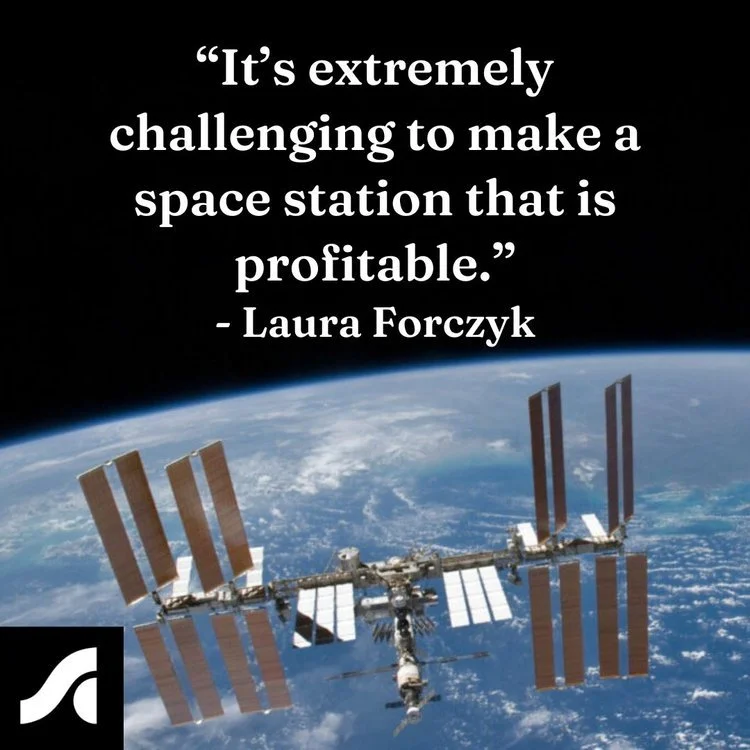Can Starship replace commercial space stations?
Want space insights like these in your inbox? Subscribe for weekly analysis.
First, a huge congratulations to Virgin Galactic suborbital astronauts Alan Stern and Kellie Gerardi!
I’ve been working with Alan since 2010 to help grow and advocate for the commercial suborbital researchers community. No one has worked harder to champion suborbital research than Alan. He was so deserving of this SwRI flight and his NASA flight to come.
Alan and Kellie both graciously agreed to be interviewed for my 2nd book, Becoming Off-Worldly (2022), in a chapter dedicated to commercial astronauts conducting research in space. I’ve truly admired the way Kellie has used social media to raise awareness of spaceflight, suborbital research, and space motherhood.
Although I’m still skeptical of Virgin Galactic’s business cases, safe and transparent operations, and long-term sustainability, I’m pleased to see that the company has made so much progress this year. I wish them many more successful flights!
Second, I’m asking you to pause for a moment and think of someone who you think would be interested in the future of SpaceX’s Starship and commercial LEO destinations (CLDs – aka commercial space stations).
Please consider forwarding this newsletter to that person. These weekly newsletters are brand new, and with your help, can reach the people who would benefit the most from them.
Thank you!
Sincerely,
Laura Forczyk, Executive Director
Photo courtesy of SpaceX
Can Starship replace Commercial Space Stations?
The next SpaceX Starship orbital test flight could be as soon as mid November, possibly November 13. Is the future of Starship in low-Earth orbit (LEO)?
Turning rocket stages into space stations in LEO is not a new idea. It predates SpaceX by decades. But with Starship being its own transportation off-Earth, and with it’s massive size and capacity, can we expect Starship to push commercial LEO destinations (CLDs) out of existence?
Nov. 2021’s CLD awardees
Axiom Space (Axiom segments will detach from the ISS to become a free-flying Axiom Station)
Orbital Reef (Blue Origin and Sierra space – for now, although there are rumors of a split – plus other partners)
Starlab (Nanoracks, Voyager Space, and other partners)
Northrop Grumman awarded a contract, decided against going it alone, and joined the Starlab effort
SpaceX proposed converting its Starship concept into a commercial LEO destination using the prototyping it was already doing for the Artemis Program lunar Human Landing System (HLS) contract. Its proposal was not chosen by NASA.
Nov. 2021’s CLD Source Selection Statement on SpaceX’s proposal
Strengths:
Proven speed, safety, and systems engineering in vehicle manufacturing
Early prototype and demonstration plan for HLS can increase technical maturity on some CLD systems
Comprehensive and proven safety and risk management approach (SpaceX has been flying astronauts to the ISS using Falcon 9 and Crew Dragon since May 2020)
More than 2 crew members at initial operations
A strong approach to future commercial communications including the maturity of Starlink
A proven design and strategy for rendezvous and docking (lots of Dragon-ISS docking experience)
Rapid development of Starship
Use of in-house developmental resources, no dependence on outside suppliers
Strong financial resources, which increase the likelihood of successful execution in the event of cost overruns (inevitably).
Weaknesses:
Lack of definition on its CLD concept and external payload accommodations
Lack of payload capabilities definition in proposed conversion of HLS into a CLD
Lack of detail for scaling up ECLS from a short to long duration capability
Limited available payload power for its proposed CLD
Proposing a single docking part, which reduces crew and cargo access to the CLD
Lack of business strategy
June 2023’s Collaborations for Commercial Space Capabilities-2 awardees
This year, NASA chose several proposals to award unfunded Space Act Agreements. These companies do not receive NASA funding, but they receive NASA resources in the form of NASA personnel time and facility use.
Blue Origin
Northrop Grumman Systems Corporation
Sierra Space Corporation
Space Exploration Technologies, Inc. (SpaceX)
Special Aerospace Services, LLC
ThinkOrbital, Inc.
Vast, LLC
June 2023’s Collaborations for Commercial Space Capabilities-2 Source Selection Statement
Strengths:
Size and reduced cost
Applications beyond LEO
Self-fund Starship development
Weaknesses:
Lack of a schedule
Insufficient information for aspects of its Starship system capability concept
Starship Space Station’s Business Case
To date, SpaceX's non-government human spaceflight customers have been primarily tourism:
Inspiration 4/Polaris Program
Axiom Space's ISS customers (private individuals and non-US government representatives)
It is very difficult to secure commercial space station users for CLD concepts to become profitable. NASA will be an anchor tenant. We can assume other governments will want to be involved. But purely commercial business cases have yet to be proven.
Axiom Space, Orbital Reef, and Starlab have announced users and potential users in the areas of R&D, agriculture, manufacturing, and entertainment.
SpaceX has yet to announce users or potential use cases for Starship in LEO. Tourism and government research seems the more likely initial users.
Astralytical Analysis
In the short-term:
At least one CLD concept will become operational.
Starship will complement CLDs with shorter duration Leo missions optimized for a single purpose.
In the long-term (2030+):
Starship’s original and ultimate purpose is to transport humans to Mars
Starship will continue NASA Artemis missions (top priority) and perhaps commercial lunar missions
Starship could become a major LEO commercial space station competitor if SpaceX sees a business case to do so
Why are long-duration LEO space stations necessary?
Most of humanity likes to travel to stable destinations rather than temporary outposts.
NASA and partners will want a facility or multiple facilities for international cooperation and geopolitical leadership (counter to China’s Tiangong space station)
The US plans to expand the ISS National Laboratory to commercial space stations to conduct longer-term science
Recent Astralytical Insights
Photo courtesy of ESA
A Critical Look: European Orbital Launch
By John Holst
A few years ago, in 2021, Arianespace achieved a milestone: it conducted 15 successful launches in a year. That launch total was well above the ~10 launches the company usually conducted annually.
Recently, though, Arianespace hasn’t even come close to that annual average. In 2022, the company launched just five times. By 2023’s end, Arianespace will have launched 1/5th of its 2021 record—three.
Why are European launches declining? Is Soyuz to blame? Is it because Ariane 6 isn’t ready? Is it something else?
Astralytical in the News
After ISS, will a new home materialize for NASA?
Laura Forczyk, the founder of US space consulting firm Astralytical, agrees that the market potential is a little unclear. “I don’t believe anybody expected all four of the commercial space station awardees to have operational space stations because of the business case,” she says. “It’s a risky business, and we know from the International Space Station that it is very expensive to run a human-rated platform in space. It’s extremely challenging to make a space station that is profitable.”
Thank you for being part of the Astralytical community! Contact us to discuss how we can help you grow your business in space.




